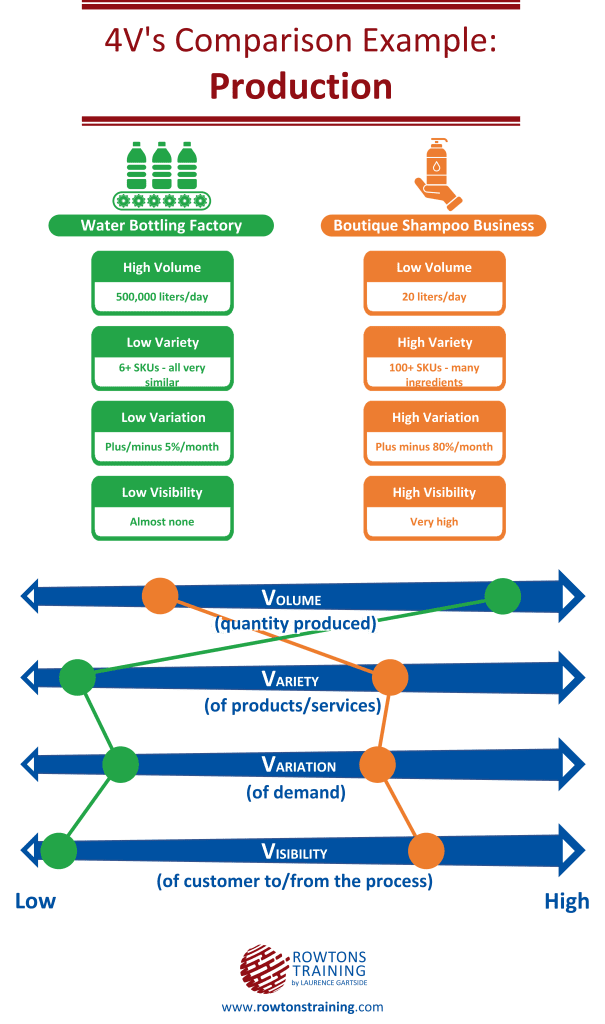What are the 4Vs of Operations Management?
The 4Vs – the 4 dimensions of operations are: Volume, Variety, Variation and Visibility. They can be used to assess all different types of business operations and understand how any why they operate, their key competitive strengths, weaknesses and different approaches. Using the 4Vs model, we can take what seem to be utterly incomparable industries and start to make sense of them, their structure, priorities and decisions by being able to place them somewhere on that sliding scale of each of the 4 dimensions of Volume, Variety, Variation and Visibility.
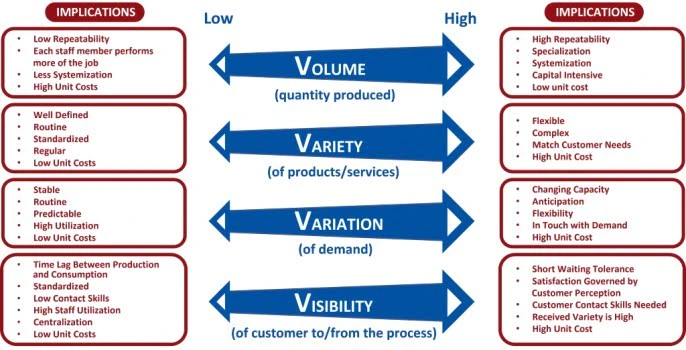

Rowtons Training offers operations management training courses on various aspects of business operations, including Logistics Management, Supply Chain Management and Inventory Management. If you want to learn more about the 4Vs in particular, check out our video on the subject.
Download Implications and Examples of the 4Vs
Volume, Variety, Variation and Visibility
The 4Vs are the 4 dimensions that fundamentally determine the nature of any business’s operations and allow us to categorise, compare and understand their nature, structure, challenges and approaches. Business operations vary wildly. To understand how we can apply and focus on the core operations-management challenges that affect all of them, we need to be able to make sense of the huge spread of organisations and categorise them; and the 4Vs is a framework to do just that.
But it offers more than that!
Take your “Operations Management” to the next level!
Whichever particular type of business you are already in, it gives us structure to look at how we can refine the positioning of our business to gain a competitive advantage through strategic choices.
The 4Vs model provides structure, giving us a means to place and evaluate wildly different types of business operations and offering insight into why certain operations can or must operate in a certain way whilst others could never work following a similar approach.
For more information, check out the video version of this blog.
Template of Evaluate Your Business on the 4Vs of Operations
Template of Evaluate Your Business on the 4Vs of Operations (Excel Format)
10 Fundamentals of Operations Management
Volume
The first of the 4 Vs is “Volume”.
“Volume” refers to the “quantity” of products or services produced by an organisation. Some very high-volume businesses may make millions of items each year, for example, a water-bottling plant, while others make only make a few items each year, for example, a boutique artisan sculptor workshop.
Generally, a high-volume business will have a high product and process repeatability and will have specialised labour, processes, and equipment. Therefore, the business is likely to be capital-intensive, because of the large amount of expensive equipment and buildings, which are optimised for such high-volume production and can provide the low unit costs that are typically essential to compete for high-volume operations.
Low-volume business operations, making a small number of things or providing a small number of services each year will rarely have such expensive or specialised equipment, buildings, processes, or skills as it cannot be justified for such low-volume output and they must instead compete on other factors than costs such as customisation or short lead times.
FREE MINI COURSE – The Forgotten Fundamentals of Operations Management
Variety
‘Variety’ is the second of the 4Vs, and this refers to the number of different “types” of products or services produced and how different they are from each other.
A business may be very specialised, with next to no variety in the products in makes, for example, a water-bottling plant with just 1 type of product. Or, a business could have a huge variety, for example the artisan workshop, which produces a series of unique pieces, each completely different from the last.
Challenges of a high-variety business include:
- Complex process routings
- Complex supply chains
- A need to be more flexible
- Matching the customer needs to exactly what they want
- A higher unit cost
These challenges mean that it is often difficult for high-variety businesses to compete with specialised businesses on price. High-variety businesses are usually low-volume, and vice versa.
In the Rowtons Training introductory 3hour “Operations Management A-Z” training course, you can learn more about the trade-off between volume and variety, and in particular the implications on cost, flexibility and customisation, giving yourself a comprehensive grounding in the fundamentals of Operations Management.
The 4 Dimensions of Operations
Variation
‘Variation’ is the third of the 4Vs – the 3rd “dimension” of operations. It refers to the level of change and predictability of demand that a business’s operations experience. Some operations will experience very high demand variation, for example due to seasons, days of the week or customer unpredictability.
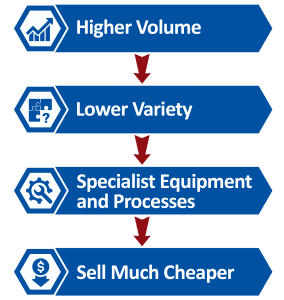
Variation also refers to how “predictable” the level of change in demand is – the demand uncertainty. For example, ice cream vans will always sell more ice cream during the summer months but they know this and can plan, but an emergency hospital department may have similar large swings in demand but cannot predict if or when this might happen. High variation of demand is simply a reality of many business operations but should always be actively minimised where possible. Demand Management typically seeks to smooth the demand, reducing the uncertainly and variation of the load placed upon the operations.
Take your “Operations Management” to the next level!
Businesses with a high variation of demand will need to:
- Have the flexibility to change their capacity
- Be good at anticipating changes in demand based on cues
- Stay close to true customer demand
- Have buffers of inventory, capacity, and time available to be able to react and deliver
- All of these things cost business money. This means that high-variation businesses often have higher unit costs but can charge higher prices if they are able to react and deliver.
Visibility
‘Visibility’ is the last of the 4Vs. It refers to the visibility of the customer to the business and its processes, and of the business to the customer. Some operations will be low-visibility, e.g., a water treatment plant, or a supermarket, whose operations work remotely from their customers. Other operations will be high-visibility, e.g., a coffee shop or an estate agent.
Customers of high-visibility businesses will have a lower tolerance for waiting, and customer satisfaction is more based upon perception of the quality and the attention to detail. High-visibility businesses need to have a more client-oriented service or process, resulting in a higher unit cost.
Organizations with “high visibility” operations, need to be much more apt at dealing with customers, giving more attention to customer contact skills and presentation where as those with low “visibility” others can focus more on their processes in privacy and are judged on the end results of cost, quality, output, delivery etc.
Typically, more customer contact (high visibility) leads to higher costs – but – also you can charge higher prices if you’re doing it well!
10 Fundamentals of Operations Management
Comparing two businesses using the 4Vs model
We can use the 4Vs model to compare two very different businesses;
A high-volume water-bottling factory and a very low-volume boutique, personalized shampoo making business (think a mom&pop home business).
Using the 4Vs framework lets us consider how the two businesses vary, why they are set up in a certain way, and their likely key competitive advantages and challenges.
Volume:
Water Bottling Factory:
In terms of volume, the water-bottling factory stands as a pinnacle of high-volume (high quantity) production. Operating at a staggering rate of maybe 500 bottles per minute (many are much more!), it epitomizes process repeatability and specialized machinery. The capital-intensive nature of the operation, coupled with economies of scale, ensures remarkably low unit costs – key to its market competitiveness.Personalized Shampoo Business:
Contrastingly, the personalized shampoo business operates on a “much” smaller scale, producing maybe only 20 liters a day. This business is likely to focus and compete on customization and flexibility. Low volume, high variety, and high variation prohibits investing in overly specialized (very expensive) equipment seen in high-volume / low variety industries.Variety:
Variety introduces a new layer of complexity. While the water bottling factory may offer a minimal range, with maybe just five unique SKUs of different water bottle sizes (which are still all essentially very similar), the personalized shampoo business likely has a vastly larger product variety, perhaps several hundred different products.
However, this high variety comes with challenges such as complex process routings and supply chain management challenges for so many different raw materials with uncertain demand – causing inventory, storage, working capital issues or frequent stockout and expensive expedited deliveries.
Variation:
Examining variation in demand, the water bottling factory has very low variation of demand for its products. It can operate with a stable production schedule running 24/7 (still very demanding, but stable). In contrast, the personalized shampoo business faces high demand variation. Orders are very unpredictable in the short term, plus large predictable variation from seasonal trends (e.g. Christmas surge).Visibility:
Visibility between the customer and business operations is a crucial aspect. It is another key defining factor of business operations with major implications on the business structure and competitive priorities. The water bottling factory operates with minimal visibility. The end consumers have essentially zero visibility of the business operations of bottling water and even the intermediate customers, the distributors / supermarkets have very little contact. Conversely, the personalized shampoo business thrives on high visibility; engaging directly with the end customers, offering a personalized touch for which the customers pay a great premium and forms a key part of the product / service offering. The high visibility takes the form of much direct customer interaction. Therefore, the boutique shampoo business focuses on attention-to-detail, customer care, and customization. These elements are pivotal to the business’s value proposition, setting it apart from the many other mainstream shampoo providers.Other comparisons:
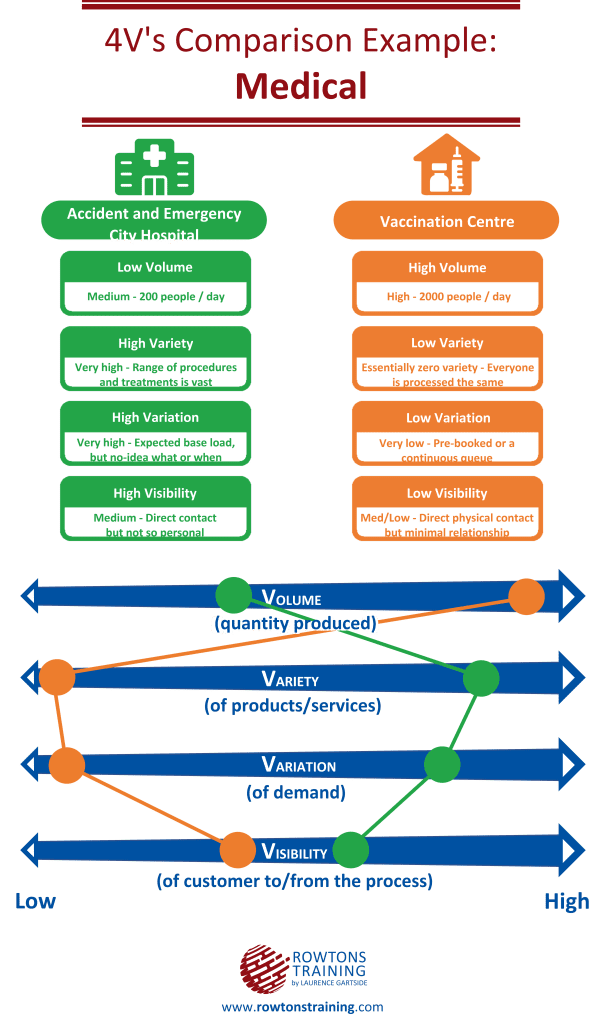
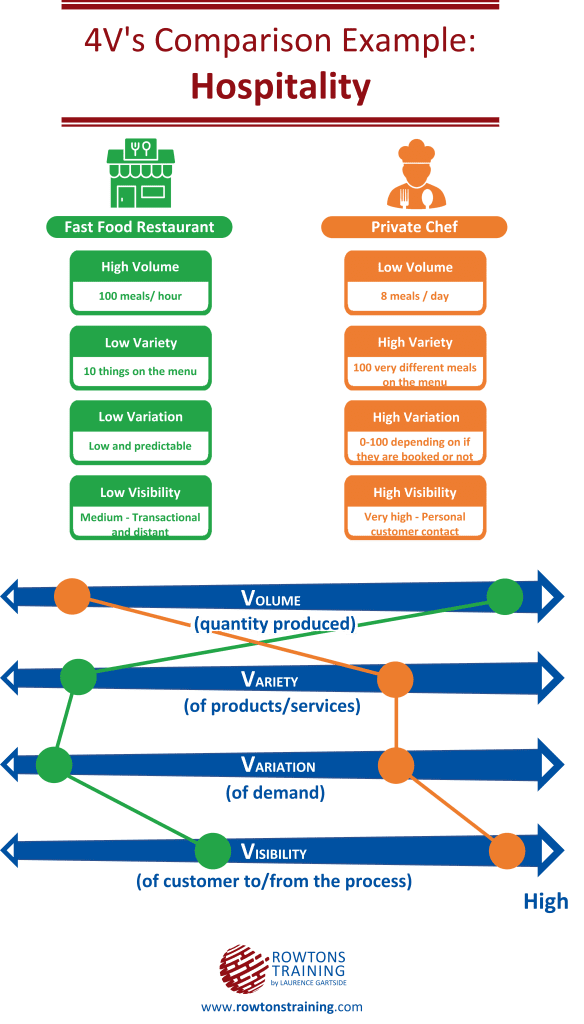
Summary
By applying the 4Vs of operations framework to case-study comparison examples, we can see how these 4 key dimensions shape the particular business and even how two businesses providing essentially the same product can do it in incredibly different ways, which can cause huge differences in how they might sensibly choose to setup, compete and operate. Understanding the interplay of Volume, Variety, Variation, and Visibility allows businesses to make strategic decisions tailored to their unique operational needs. For a more dynamic understanding, we encourage you to watch the accompanying video. Additionally, explore our Operations Management training courses at Rowtons Training to delve deeper into the fundamentals of Operations Management.Crack On!






